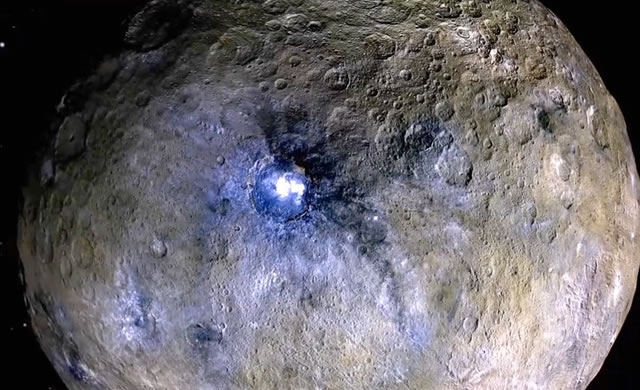
Credit: NASA/JPL-Caltech/UCLA/MPS/DLR/IDA
Quella strana foschia su Cerere – Un nuovo studio guidato da astronomi dell’INAF con telescopi da terra conferma le indicazioni fornite dalle riprese super dettagliate della sonda Dawn: ovvero, che il pianeta nano sembra mostrare una propria attività interna. Attività che si manifesta attraverso la variazione di luminosità delle sue enigmatiche macchie brillanti.
Cerere, il più grande oggetto della fascia degli asteroidi tra Marte e Giove e anche il più vicino pianeta nano, sembra mostrare tracce di attività sulla sua superficie, differenziandosi dagli altri corpi celesti che lo circondano. Lo suggeriscono le bellissime immagini ad alta risoluzione della sonda Dawn pubblicate nel dicembre scorso su Nature e, ora, un nuovo studio con telescopi da terra guidato da un gruppo di astronomi dell’INAF. Quasi un anno fa, la sonda Dawn raggiungeva Cerere e da allora, in orbita stabile attorno al corpo celeste, ne sta perlustrando la superficie e investigando le proprietà fin nei più piccoli dettagli. Già le prime immagini ravvicinate rivelarono una costellazione di macchie particolarmente brillanti e in particolare quelle localizzate nel cratere Occator (diametro 92 km), come si può vedere dalla mappa di Cerere qui riprodotta. Nell’ articolo su Nature, Nathues e collaboratori affermano che l’ aspetto delle aree luminose localizzate nel cratere Occator sarebbe consistente con la presenza di solfati idrati di magnesio. Sul fondo del cratere ci sarebbe qualcosa che fuoriesce dall’interno e che sublimerebbe producendo una foschia con carattere periodico, cioè che appare e scompare nel giro di poche ore. La figura a destra mostra una opacità diffusa che riempie il cratere Occator alla sua alba, ma che scompare quasi completamente al crepuscolo.
Fonte/Leggi tutto → Media.Inaf.it
That strange haze on Ceres – A new study with ground-based telescopes conducted by a team of INAF astronomers strengthens the hypotheses provided by the Dawn spacecraft images: the dwarf planet seems to have an internal activity on its own which becomes evident when the light intensity of the mysterious bright spots varies.
Ceres, originally called Cerere Ferdinandea, is the largest asteroid in the main belt of the solar system and the first to be discovered. In September 2007, NASA launched the Dawn spacecraft, which entered into stable orbit around Ceres on 6 March 2015 to observe the dwarf planet surface, initially from an altitude of 5,900 km, which was then decreased to 1,300 km and finally brought to 700 km for additional five months.
The unprecedented images of Ceres surface collected by the Dawn spacecraft show the features of the dwarf planet surface: mountains, craters and fractures and reveal a constellation of particularly bright spots, especially those located in the Occator crater. Now that the probe is at the right distance, researchers hope to clarify the nature of the bright spots that stud the planet surface. The high-resolution images of Ceres look different from those of the other celestial bodies surrounding it, and show traces of activity on its surface. Now, a new study with ground-based telescopes conducted by a team of INAF astronomers strengthens the hypotheses provided by the Dawn spacecraft images: the dwarf planet seems to have an internal activity on its own which becomes evident when the light intensity of the mysterious bright spots varies.
Source/Continue reading → Inaf.it/en






















Pingback: C’è acqua su Cerere – Foto Macchie Brillanti e Nuovi Dettagli – Bright Spots and Color Differences Revealed on Ceres | DENEB Official ©